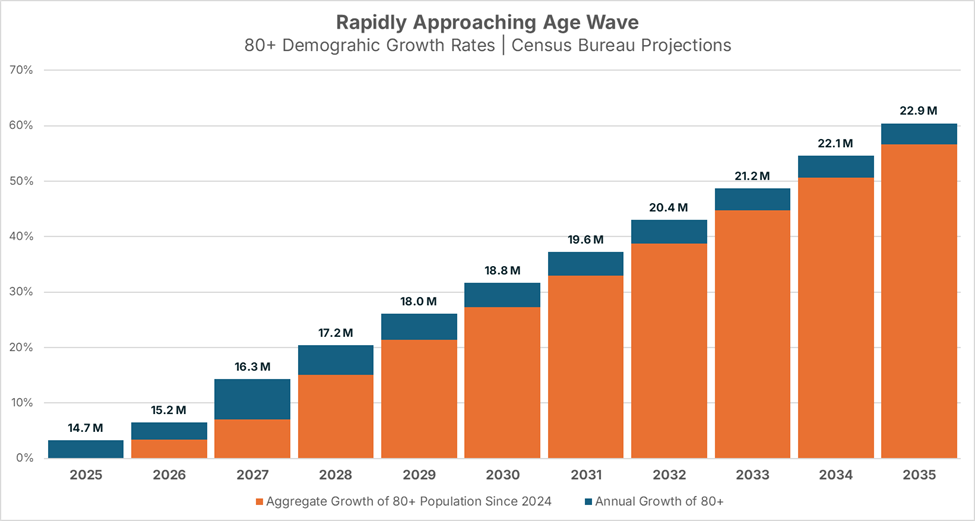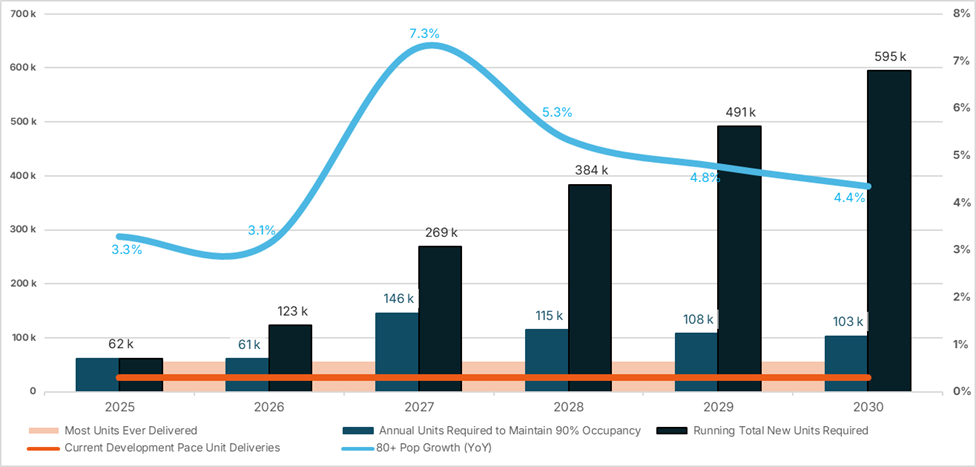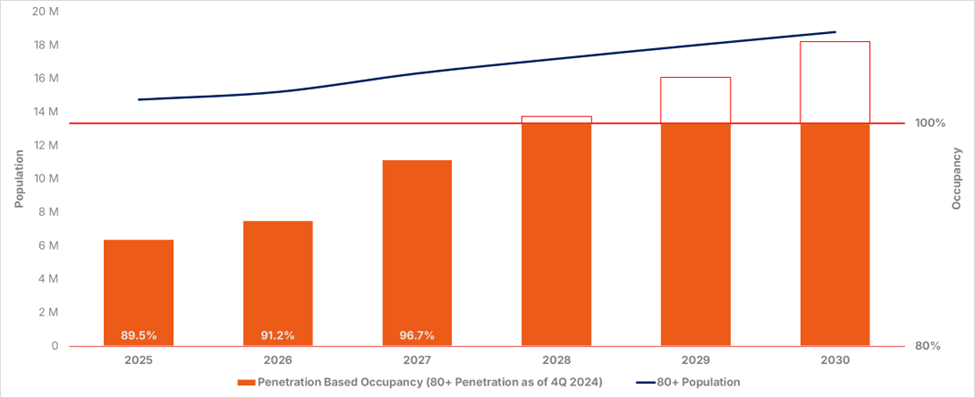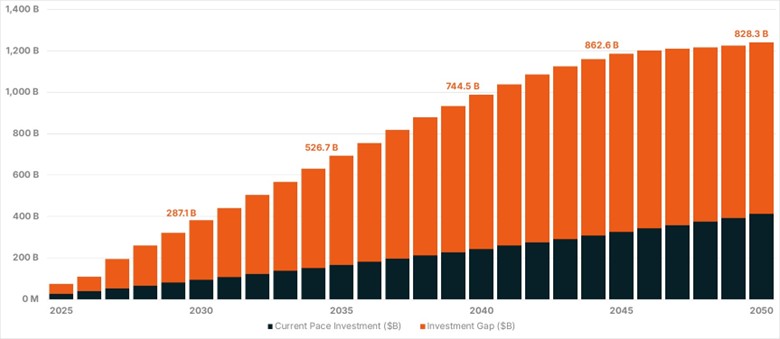The Impending Age Wave
Navigating the Urgent Need for Senior Housing
As Baby Boomers enter their retirement years and beyond, the country’s aging population is rapidly expanding. In fact, the 80+ population will grow by more than a quarter in the next five years, and nearly double by 2035. The impending ‘age wave’ or ‘boom’ in demand requires the attention of businesses focused on providing, operating, and investing in senior housing.
The Aging Wave: A Rapid Surge

To understand the opportunity ahead, let’s dive into the shifting population data. It shows a swift and substantial increase in the population aged 80 and above. According to the US census, the 80+ population will increase to 14.7 million people (3.4%) in 2025 alone. But this year is not an outlier in the upward trend. The growth of the senior population will continue its increase from this year’s figures, growing by 16.6% by 2028 and by almost 28% by 2030. By 2035, in just ten short years, our 80+ population will increase from 14.7 million to nearly 23 million, a growth rate of over 55%.
These statistics show that the ‘age wave’ is not just a distant future scenario, but is rapidly approaching, and that its impact will be felt across the entire senior living sector. In fact, according to the Census, the growth rate of this demographic will outpace every other age group, highlighting an urgent need to prepare for the inevitable surge in demand for senior housing and care facilities.
Evolving Needs of Seniors
Moreover, the aging population is not just growing; it is evolving. Recent research by the National Institute on Aging and World Health Organization (“Global Health and Aging”, 2025) reinforces anecdotal information that today’s seniors are living longer and healthier lives than the generations before them. Alongside this positive trend is an increase in care and acuity needs in senior housing: because they are entering congregate housing at an older age, they are more affected by chronic conditions and age-related ailments. More serious needs require specialized care, and as these needs rise, the support systems will also change.
In years and generations past, adult children or spouses often shouldered the responsibility of caregiving for older loved ones. Modern societal dynamics, including smaller family sizes and increased geographic mobility, mean that there are fewer caregivers available within families. This shift underscores the need for congregate care environments that can provide seniors with the necessary support and sense of community they need.
Senior housing offers seniors services that are increasingly absent in our modern society for older Americans: a sense of community, increased social engagement, and care services, all under one roof. Within these communities, as they increase the value and presence in seniors’ lives, the sector must balance affordability with quality. Key to lowering the cost of senior housing is increasing the supply of available inventory.
Inventory Challenges: Keeping Pace with Demand

To maintain the current market penetration rates in the senior housing sector, substantial near-term growth in housing inventory is imperative. Just using existing current penetration rates, NIC MAP data still predicts a need for over 250,000 additional senior housing units by 2027, nearly 500,000 additional units by 2029, and almost 600,000 additional units by 2030. However, simply ‘maintaining’ the current market penetration rates in anticipation of an aging population may not be enough. In fact, this is only a conservative estimate because, according to the US census, the ratio of the senior population (age 80+) to the adult child or caregiver population (age 45-64) will continue to narrow as the boomer generation ages into senior status.
In addition, the senior housing industry is currently in a period of decline for new construction starts. In 2024 alone, NIC MAP estimates that nationally, only 14,000 new units came online. Even more troubling, when consumer need inevitably drives an accelerated construction cycle, it may not be fast enough to keep up with growing demand. Senior housing projects take one to two years to complete from groundbreaking, placing the arrival of future units far behind the anticipated demand.
In a scenario where the senior housing supply falls short of demand, seniors may find themselves navigating a landscape with limited housing options, forced to make unwanted compromises on quality or location of their housing. Furthermore, scarcity leads to increased costs, which may make senior housing unaffordable for many who need the safety, community, and well-being it provides.
The $300 Billion Gap: A Call for Action

The above graphic illuminates one of the most pressing concerns within the senior housing industry. That is, the significant gap between the current pace of development and the pace required to meet the burgeoning demand driven by the growth of the 80+ demographic. If current trends hold, seniors housing demand will outstrip available supply in the next few years. Although there is ongoing development of new senior housing units, the pace at which these projects are being completed falls significantly short of what’s required to accommodate the rapidly growing population of seniors.
In short, many seniors might find themselves lacking suitable housing, and increasing difficulties in affordability, accessibility, and quality of care. To bridge this gap in supply, the industry must significantly accelerate its development efforts.
The $1 Trillion Requirement: Ensuring Housing for All Seniors

To meet this anticipated demand, the sector will need heavy investment in new developments and re-development. In fact, by 2030, our current projection show that we will meet only 1/3rd of the nearly $300 billion in new development needed to meet anticipated demand. By 2040, the current investment pace will barely exceed a quarter of the required investment need. But there are silver linings, as investment in senior housing is increasing as clever capital providers recognize the value of serving our aging seniors. These figures underscore the increasing mismatch between supply and demand in senior housing and care services. At the current rate of development, investment is not keeping pace with the needs of an aging population, and without substantial increases in funding and accelerated development, there will be a severe shortfall in housing capacity for older adults.
Navigating the Future
As the aging population accelerates toward unprecedented levels, the senior housing industry stands at a critical crossroads. This strong demand presents a golden opportunity for stakeholders in the senior housing industry; and the data is clear: without bold, coordinated action, the sector risks falling further behind the needs of the growing 80+ demographic. Addressing this challenge will require a concerted effort from developers, operators, investors, and policymakers to prioritize the expansion of senior housing inventory and innovate new models of care that balance quality, affordability, and accessibility. This is not merely an opportunity; it is an obligation to ensure that older adults have access to safe, supportive, and community-oriented living environments.
The key to moving forward with confidence? Data-driven decisions powered by NIC MAP. Discover more by connecting with our team of experts today.
